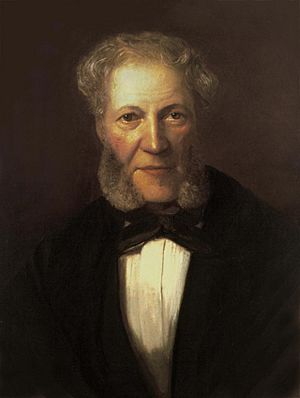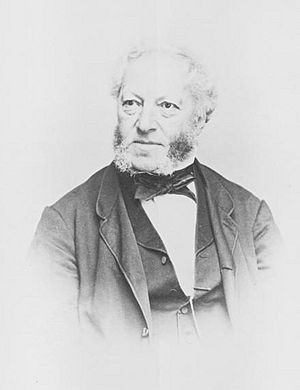Ignaz Moscheles facts for kids
Isaac Ignaz Moscheles (born 23 May 1794 – died 10 March 1870) was a famous composer and amazing piano player from Bohemia (which is now part of the Czech Republic). He first lived and worked in London, England. Later, he moved to Leipzig, Germany, where he became a piano professor at the Conservatory. He joined his good friend and former student, Felix Mendelssohn, there.
Contents
A Musician's Life Story
Early Years and Musical Start
Ignaz Moscheles was born in 1794 in Prague, Bohemia. His family was wealthy and spoke German. His first name was originally Isaac. His father played the guitar and really wanted one of his children to become a musician. At first, he hoped Ignaz's sister would, but she didn't want to. So, her piano lessons went to Ignaz instead.
Ignaz quickly fell in love with the piano music of Beethoven. This music was quite new and exciting at the time. His teacher, Bedřich Diviš Weber, tried to make him focus on older composers like Bach, Mozart, and Muzio Clementi.
After his father passed away, Moscheles moved to Vienna, Austria, in 1808. He was so talented that he could study with famous teachers there. He learned about music theory and composition from Albrechtsberger and Salieri. Around this time, he changed his first name from "Isaac" to "Ignaz."
He became one of the top piano players in Vienna during a big meeting called the Congress of Vienna in 1814–1815. During this time, he wrote his very popular Alexander Variations, Op. 32, for piano and orchestra. He played this piece all over Europe. He also became close friends with Giacomo Meyerbeer, who was a piano player then, not yet a composer. They often played piano duets together, which people loved. Moscheles also knew other famous musicians like Hummel and Kalkbrenner.
While in Vienna, Moscheles finally met his hero, Beethoven. Beethoven was so impressed with the young Moscheles that he asked him to create the piano version of his opera Fidelio. When Moscheles finished, he wrote "Finished with God's help" on the music. Beethoven approved, but added, "O Man, help thyself!" Their good relationship became very important later, especially when Beethoven was nearing the end of his life.
Family and Beliefs
Ignaz Moscheles came from a Jewish family. When he lived in Vienna, he was part of the Jewish community. He even wrote a special music piece for them to celebrate peace. Throughout his life, he stayed friends with other musicians who also had Jewish backgrounds, like Felix Mendelssohn and Joseph Joachim. He also kept in touch with wealthy families who supported musicians.
In 1825, Moscheles married Charlotte Emden in a synagogue in Hamburg, Germany. Charlotte was the daughter of a banker and a cousin of the famous writer Heinrich Heine. After moving to England, Moscheles became a member of the Church of England.
His children, two sons and three daughters, were all baptized when they were born. Ignaz and Charlotte themselves were baptized in 1832. Their son Felix (1833–1917) and daughter Serena Anna Moscheles (1830–1902) both became painters. Serena married Georg Rosen, who was a scholar. Ignaz Moscheles's granddaughter Jelka Rosen also became a painter and married the composer Frederick Delius. Another granddaughter, Marie-Thérèse, married Henry Fielding Dickens, the son of the famous author Charles Dickens.
Moscheles traveled a lot around Europe, playing piano and leading orchestras. He finally settled in London, England, from 1825 to 1846. In 1832, he became a co-director of the Royal Philharmonic Society. Even after moving to England, he never forgot his Jewish roots and often visited his relatives in Prague, who remained Jewish.
Friendship with Mendelssohn in London
After his time in Vienna, Moscheles went on many successful concert tours across Europe. When the young Robert Schumann heard Moscheles play, he was so inspired that he wanted to become a piano player himself! Moscheles especially loved London. In 1822, he was made an honorary member of the London Academy of Music (which later became the Royal Academy of Music). He wrote in his diary that he felt more and more at home in England, and he decided to live there after he got married.
In March 1823, Moscheles visited Bath in England and started working on his Piano Concerto No. 4 (Op. 64). He loved the view of the Bristol Channel and the Welsh mountains, saying it was "the very place to write an adagio" (a slow, beautiful part of music). His piano concerto was first performed in London shortly after, on 16 June.
Before that, in 1824, he was invited to Berlin to give lessons to Felix and Fanny, the children of Abraham Mendelssohn Bartholdy. Moscheles was amazed by them. He said Felix, who was only fifteen, was a "phenomenon" and already a "mature artist." He felt like he was teaching a master, not just a student.
This was the start of a very strong friendship that lasted until Mendelssohn's death in 1847. Moscheles helped Felix come to London for the first time in 1829. He had prepared everything carefully for Felix's visit. In London, Moscheles became a regular and successful performer. He also advised the Royal Philharmonic Society about talented European musicians he met on his tours. When Sir George Smart, who led the Society, toured Europe in 1825, Moscheles gave him a list of contacts and introduction letters, including for Beethoven and Mendelssohn. This led to Mendelssohn being invited to conduct for the Society in 1829.
In 1827, Moscheles helped the Philharmonic Society send money to Beethoven, who was very ill and dying. In return, Beethoven offered to write his (unfinished) Tenth Symphony for the Society.
Mendelssohn became very successful in England from 1829 onwards, which also helped Moscheles. Even though some people thought Moscheles's music was a bit old-fashioned, he was in high demand as a music teacher. Many children from rich and noble families were his students. He was also named "Pianist to Prince Albert", which was an important title. A child piano genius named Elizabeth Jonas, who was Moscheles's student, played for the royal family at Windsor Castle many times.
Moscheles always promoted Beethoven's music. He gave many concerts playing Beethoven's works. In 1832, he led the first performance in London of Beethoven's Missa Solemnis. He also translated A.F. Schindler's book about Beethoven into English. He was one of the first to give "piano recitals," which are concerts just for piano music. He even brought back the harpsichord as a solo instrument. He often performed with Mendelssohn in London, especially playing Bach's concertos for multiple keyboard instruments. They were known for trying to outdo each other with amazing improvised solos.
Years in Leipzig
Even though Moscheles kept writing music and going on concert tours, he relied a lot on teaching to earn money. This caused him a lot of stress. So, when Mendelssohn started a music school called a Conservatory in Leipzig in 1843, he really wanted Moscheles to join him. Mendelssohn promised him plenty of time for concerts and making music. After a few years, Moscheles happily accepted the job in 1846. He became a very important and long-serving piano teacher at the Conservatory for many years.
The Conservatory became a special place that honored Mendelssohn's musical legacy. Moscheles had to defend Mendelssohn after Wagner wrote a critical article about Mendelssohn (and Meyerbeer). Moscheles asked for Wagner's editor to resign from the Conservatory's board. Like Mendelssohn, Moscheles believed that music was at its best from Bach to Beethoven. He was a bit unsure about new music styles from composers like Wagner and Liszt, but he usually remained friendly with them. Because of Mendelssohn's fame in Britain, the Leipzig Conservatory was very well-known among English musicians. Students like Arthur Sullivan and Charles Villiers Stanford studied there during Moscheles's time.
Ignaz Moscheles passed away in Leipzig on 10 March 1870. He had attended his last rehearsal with the Leipzig Gewandhaus Orchestra just nine days before.
Moscheles's Music
Ignaz Moscheles wrote many pieces of music, with 142 official "opus numbers" (a way to number a composer's works). He wrote several pieces for orchestra. Besides an overture (a piece played at the start of an opera or concert), a ballet, and a symphony, most of his orchestral works are for piano and orchestra. These include eight piano concertos (like a conversation between the piano and the orchestra) and many sets of variations and fantasias based on folk songs. For example, the main tune in the last part of his fourth piano concerto is based on the song "The British Grenadiers".
Moscheles also wrote several chamber works (music for a small group of instruments), including a piano trio (for piano, violin, and cello) which has been recorded. He also wrote many pieces just for solo piano, like sonatas and études (study pieces). His études were so good that advanced students continued to study them even after his other music became less popular. He also wrote some songs.
Recently, people have become more interested in Moscheles's music again. More of his works are now available on CDs. For example, all his completed piano concertos and fantasias for piano and orchestra have been recorded by Howard Shelley on the Hyperion Records label. They have also released his complete piano studies.
More to Explore
In Spanish: Ignaz Moscheles para niños




